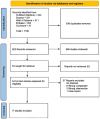Efficacy and safety of pulsed-field versus conventional thermal ablation for atrial fibrillation: A systematic review and meta-analysis
- PMID: 39416254
- PMCID: PMC11474578
- DOI: 10.1002/joa3.13118
Efficacy and safety of pulsed-field versus conventional thermal ablation for atrial fibrillation: A systematic review and meta-analysis
Abstract
Background: Pulsed-field ablation (PFA) has emerged as an innovative alternative to radiofrequency (RF) and cryoablation because it selectively targets myocardial tissue. Thus, we aim to estimate the efficacy and safety of PFA versus thermal ablation for atrial fibrillation (AF) ablation.
Methods: A systematic review and meta-analysis were retrieved from PubMed, WOS, SCOPUS, EMBASE, and CENTRAL through September 2023. We used RevMan V. 5.4 to pool dichotomous data using risk ratio (RR) and continuous data using mean difference (MD) with a 95% confidence interval (CI). PROSPERO ID: CRD42023480321.
Results: We included 17 studies with a total of 2255 patients. PFA was significantly associated with a decreased incidence of AF recurrence (RR: 0.66 with 95% CI [0.51, 0.87], p = .003). However, there was no significant difference between PFA and thermal ablation in arrhythmia recurrence (RR: 0.92 with 95% CI [0.74, 1.46], p = .42). PFA was significantly associated with decreased total procedure time (MD: -15.15 with 95% CI [-20.23, -10.07], p < .00001), decreased heart rate change (MD: -7.39 with 95% CI [-12.16, -2.62], p = .002), decreased phrenic nerve palsy (RR: 0.38 with 95% CI [0.15, 0.98], p = .05), and reduced esophageal lesions (RR: 0.09 with 95% CI [0.01, 0.69], p = .02). On the contrary, PFA was significantly associated with increased pericardial tamponade (RR: 6.14 with 95% CI [1.43, 26.33], p = .01).
Conclusion: PFA was significantly associated with decreased AF recurrence, total procedure time, heart rate change, phrenic nerve palsy, esophageal lesion, and increased incidence of pericardial tamponade compared with thermal ablation.
Keywords: ablation; atrial fibrillation; pulsed‐field.
© 2024 The Author(s). Journal of Arrhythmia published by John Wiley & Sons Australia, Ltd on behalf of Japanese Heart Rhythm Society.
Conflict of interest statement
Disclosures for Dr. Annabelle S. Volgman (October 2023) Consulting—Sanofi, Pfizer, Janssen; Clinical Trials: Janssen, Novartis and NIH Clinical Trials; Stock: Apple, Inc while the other authors declare no conflict of interest.
Figures





References
LinkOut - more resources
Full Text Sources

